White Pine Blister Rust
Cronartium ribicola
Key Wildlife Value:
White pine blister rust creates all sizes of snags by killing five-needle pines. Mountain pine beetles frequently are attracted to older trees infected with Cronartium ribicola, providing good foraging habitat for woodpeckers.
Distribution in Oregon and Washington:
Found throughout both states.
Hosts:
Western white pine, sugar pine, whitebark pine, and limber pine. Alternate hosts are currants and gooseberries (Ribes spp.).Diagnosis:
Living trees infected with white pine blister rust frequently have dead tops and scattered dead branches.
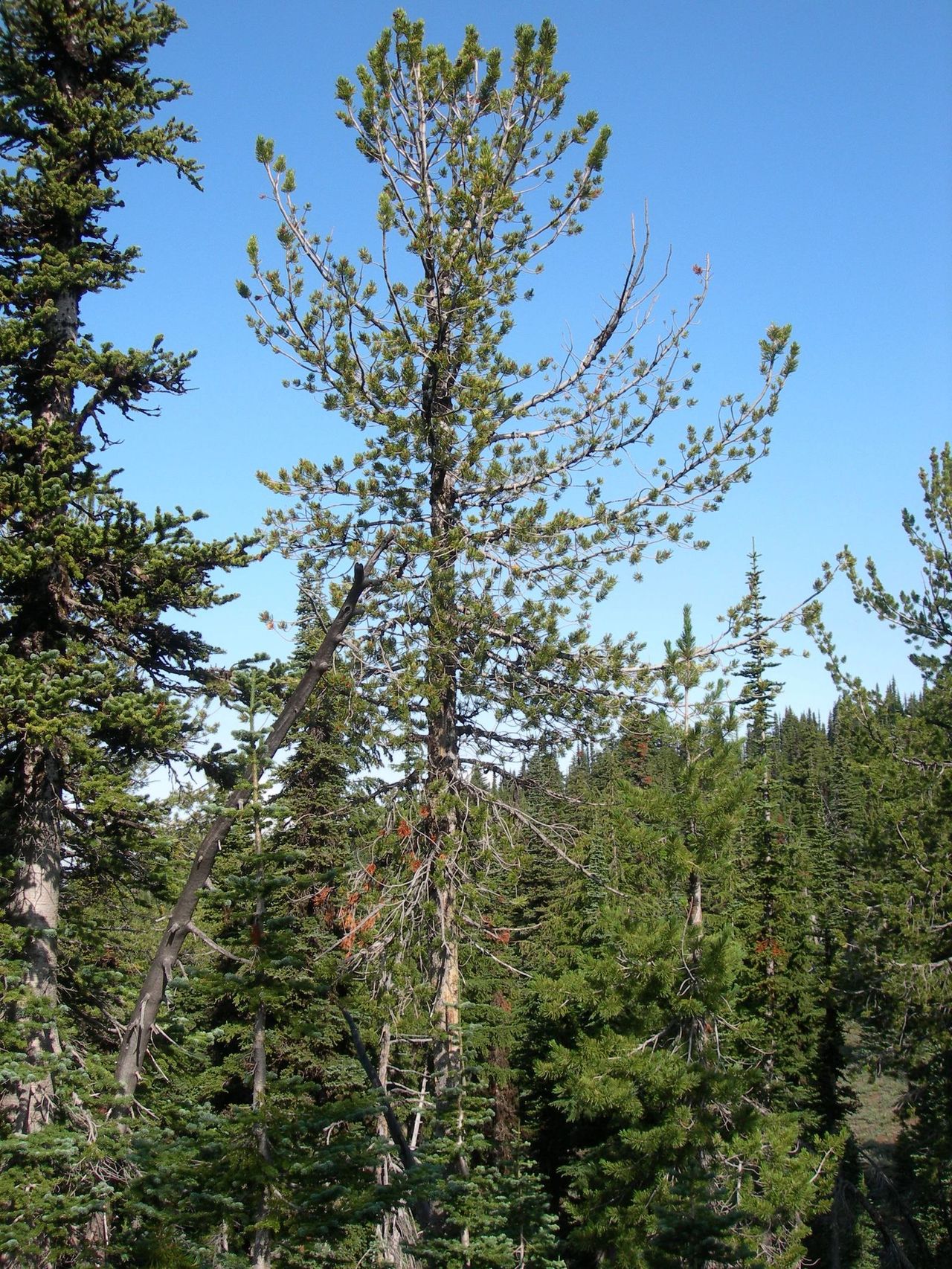

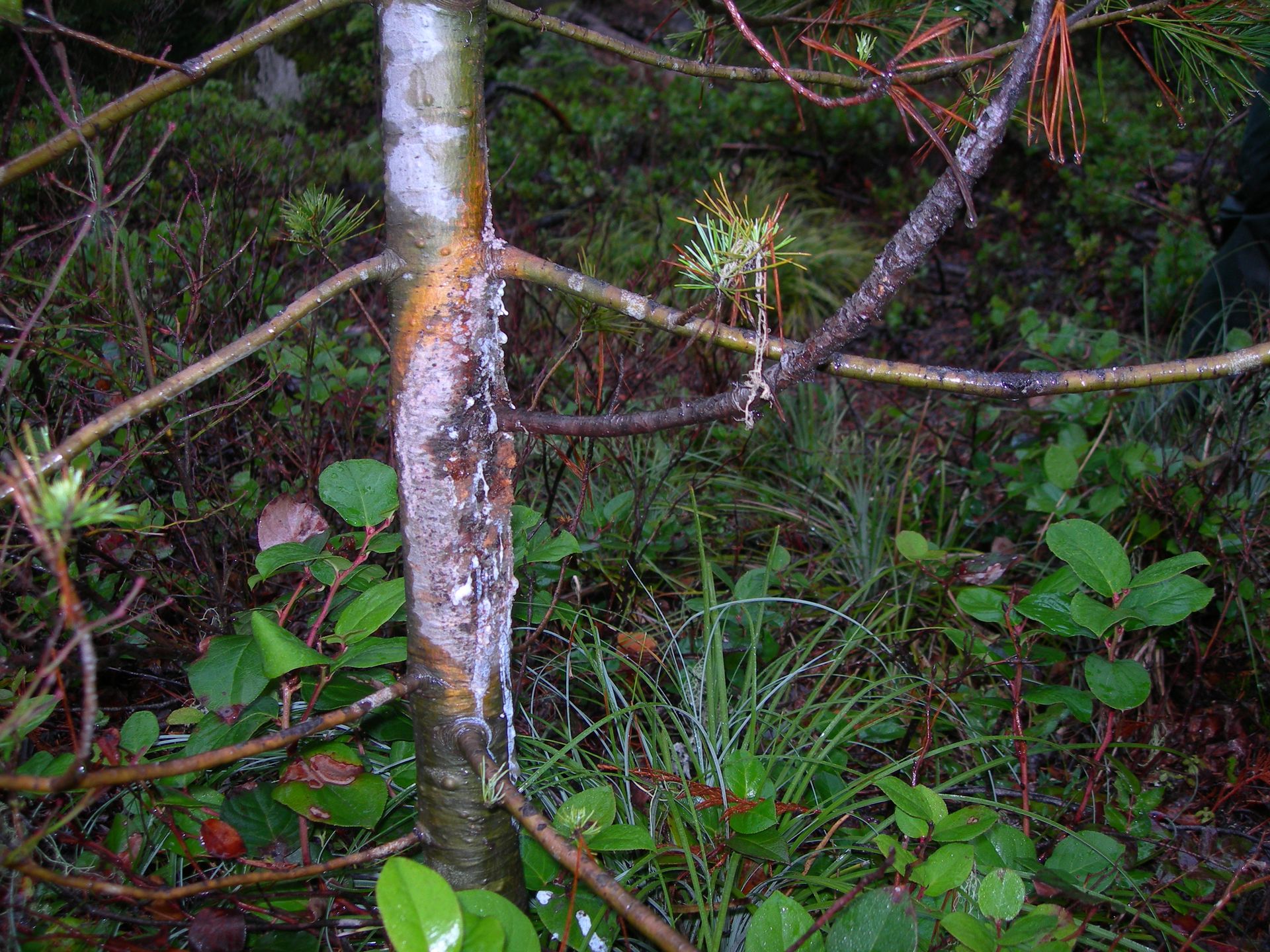
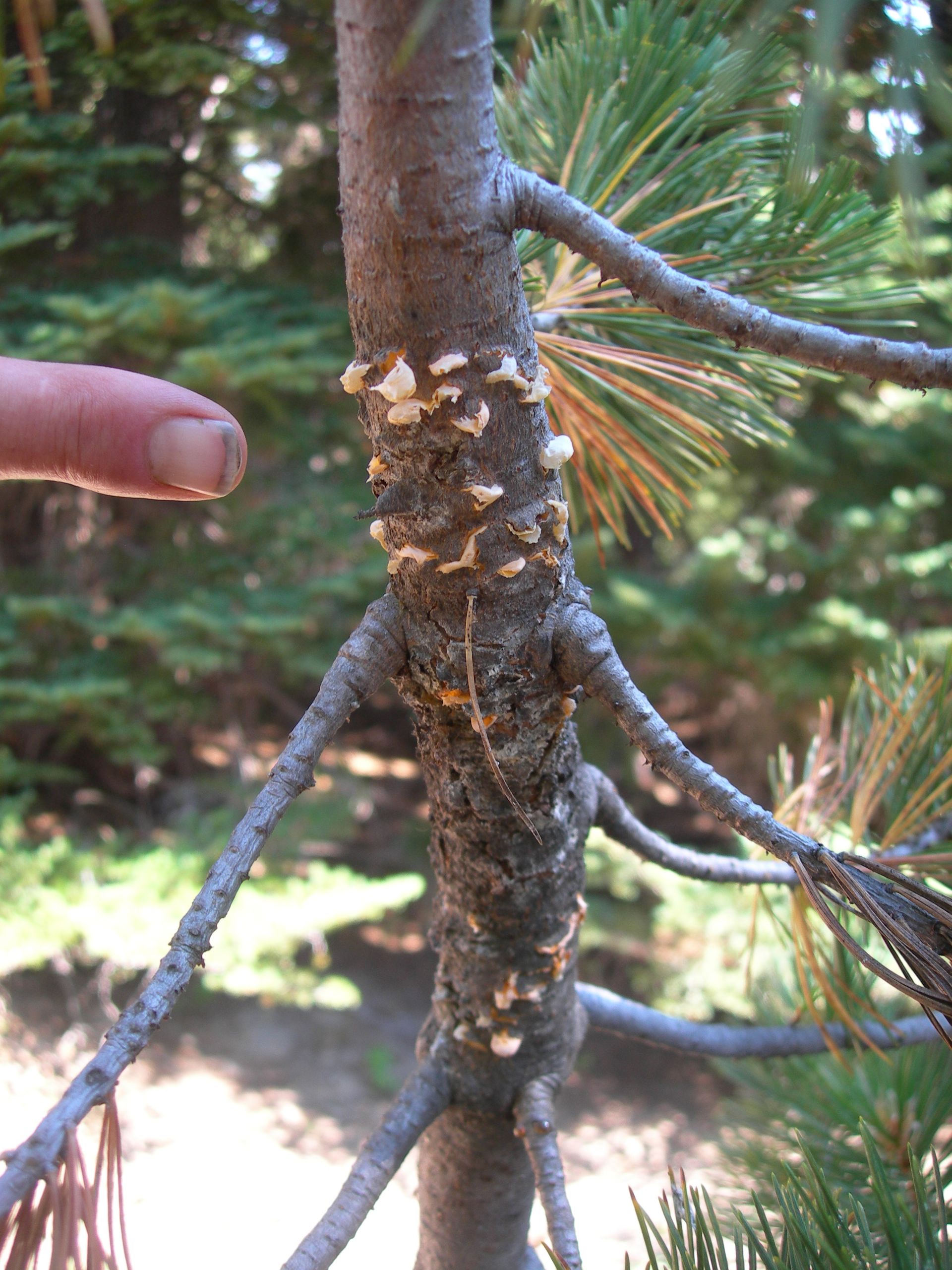
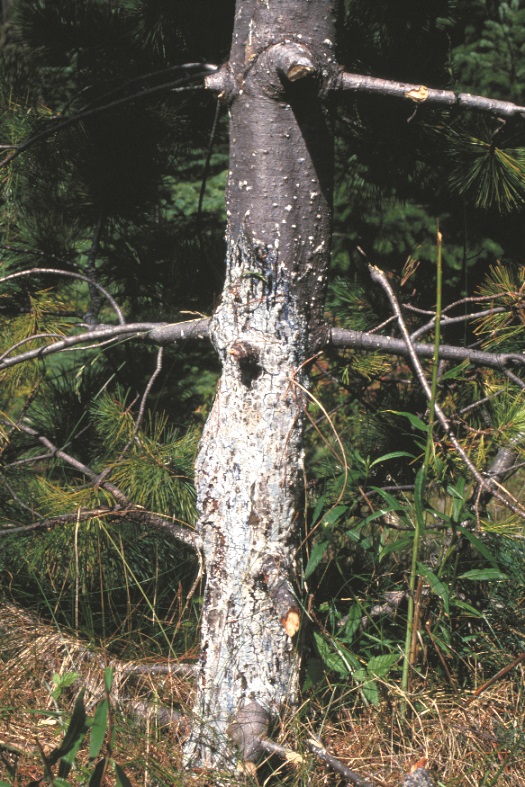

Infected Ribes spp. leaves have orange pinhead-size pustules or brown hair-like tendrils on their undersides in spring and summer and may lose their leaves prematurely.
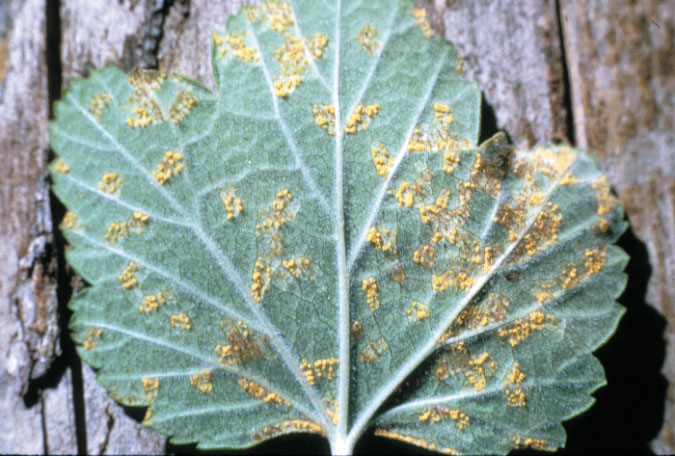
Mountain pine beetle often colonizes larger pines that are infected with white pine blister rust.
Life History:
White pine blister rust is not native to the Pacific Northwest, but was introduced to British Columbia from Europe in 1910. It is native to Asia. It spread rapidly throughout the range of western white pine and sugar pine in Washington and Oregon by 1940. The pathogen causes a canker disease on five-needle pines. The life cycle is very complex, involving five different stages (with associated spore forms) and a required phase of development on an alternate host, and it takes 4 to 5 years to complete. C. ribicola cannot survive in wood after its host dies.
Spores produced in the first stage are called pycniospores. They are exuded during spring in sap-like fluid from the margins of cankers. These spores cannot infect other hosts, rather they appear to serve a sexual function. In the second stage, which occurs later in the spring and early summer, thick walled aeciospores are formed in bright yellow-orange structures that erupt through cracks in the cankered areas. These spores are only able to infect Ribes spp., and may be blown long distances. The third stage occurs on infected Ribes spp., and involves the production of uredospores, which can only infect Ribes spp. leaves. During the fourth stage, teliospores are formed, which do not disperse but germinate in place on the undersides of infected Ribes spp. In the fifth stage, thin walled, short-lived basidiospores are formed in late summer and early fall. Basidiospores can only infect pine needles, and require high humidity and cool temperatures below about 20° C for good survival and germination. Wet weather and fog or low clouds provide favorable conditions for the infection of pine needles, as do the moist conditions typically found near the ground.
Some immunity to C. ribicola is present in natural populations, and breeding programs started in 1956 for rust-resistant sugar pine and western white pine have been providing seed from resistant genotypes for a number of years.
Important Habitats and Spread Dynamics:
Favorable habitats are provided where five-needle pines are exposed to high levels of infective basidiospores and moist conditions during the late summer and early fall. The incidence, density, and species of Ribes spp. influence the probability of host tree infection, as do topographic position, local weather patterns, and large-scale weather events that bring moist or dry conditions to a region. In many settings, high risk sites may be defined as having over 100 Ribes spp. plants per acre, and host trees with high levels of white pine blister rust infection. However, some sites that have no Ribes spp. plants have high risk because they are located where clouds or fog containing basidiospores settle. High-risk sites frequently are located on saddles, ridges, or mountain tops where summer fog is common, or in low-lying areas where cool, moist air flows or pools.
Once basidiospores land on a host needle, they germinate and the fungus grows through the needle into the branch or stem. There it causes the death of vascular tissues, disrupting the flow of nutrients and water above and below the canker. Cankers continue to grow from year to year in all directions, and when they completely encircle a branch or stem, the distal portion of the stem dies, resulting in branch killing, topkill, and whole tree mortality, depending on the placement of the canker. Stem cankers that reach the bole before killing the branch become more serious bole infections.
Lethal infections commonly form when young seedlings and saplings, which have numerous needles growing near or on the main stem in moist conditions near the ground, become infected. These infections tend to form bole infections that subsequently girdle and kill the tree. Seedlings and saplings suffer especially high rates of mortality as a result of lethal C. ribicola infections. Fast-growing trees sometimes are able to keep ahead of bole canker development for a period of by growing faster than the canker. Trees that are large before becoming infected typically develop dead branches and topkill, which can result in slow crown deterioration and subsequent lethal attack by mountain pine beetle (Dendroctonus ponderosae). Sometimes numerous infections kill enough of the branches in the crown to cause tree mortality without the occurrence of any bole infection.
Opportunities for Manipulation to Increase Wildlife Habitat:
Because C. ribicola is a non-native, introduced species and causes primarily detrimental effects in our native ecosystems, it would be highly undesirable to encourage its activity.
Potential Adverse Effects:
The overall effect of white pine blister rust has been to reduce the diversity of tree species present in many native stands, and to threaten the conservation and health of native ecosystems having a high component of susceptible five-needle pines. White pine blister rust has significantly reduced populations of western white pine and sugar pine in Oregon and Washington, and poses a major threat to whitebark pine and limber pine. High elevation five-needle pines play critical ecosystem roles in maintaining a diversity of wildlife and plant species, regulating snow and runoff, and providing cover on harsh high elevation sites where little else can grow. On high hazard sites, natural regeneration of five-needle pine pines is seriously impaired, with most individuals dying before reaching cone bearing age, while at the same time the mature infected trees currently occupying these sites are dying at an accelerated rate. In heavily impacted areas, reduced post-fire reforestation and reduced sustainability of various associated wildlife species, such as the Clark’s nutcracker, black bear, and squirrels, may result.
How to Minimize the Risk of Adverse Effects:
The incidence of infection can be significantly reduced during stand regeneration by planting five-needle pines having resistance to white pine blister rust. Several levels of resistance are available in breeding program stock. Because C. ribicola is able to mutate and form strains with varying levels of virulence, careful matching of site conditions and resistant stock is warranted to conserve existing resistance. Methods have been developed for evaluating rust hazard, risk rating infected trees, and evaluating management options for existing stands. Pruning that removes the lower branches of planted five needle pines may be used to prevent bole infections and to alter the microclimates in plantations, making conditions less favorable for the pathogen.
References
Goheen, E.M. and E.A. Willhite. 2006. Field guide to common diseases and insect pests of Oregon and Washington conifers. USDA Forest Service, Pacific Northwest Region, Portland, OR. R6-NR-FID-PR-01-06. 335 pp. http://www.biodiversitylibrary.org/bibliography/80321#/summary
Hansen, E.M., and K.L. Lewis, eds. 1997. Compendium of Conifer Diseases. American Phytopathological Soc. Press. 101 pp.
Kinloch, B.B., Jr., M. Marosy, and M.E. Huddleston, eds. 1996. Sugar pine: status, values, and roles in ecosystems: Proceedings of a Symposium presented by the California Sugar Pine Management Committee. University of California, Division of Ag. and Natural Resources, Davis, CA. Publ. 3362. 225 pp.
Scharpf, R.F. 1993. Diseases of Pacific Coast conifers. USDA Forest Service, Pacific Southwest Research Station, Albany, CA, Ag. Handbook 521 (revised). 199 pp.
Schnepf, C.C. and J.W. Schwandt. 2006. Pruning western white pine: a vital tool for species restoration. University of Idaho Extension, Oregon State University Extension Service, and Washington State University Extension, in cooperation with the U.S. Department of Agriculture, Moscow, ID. Pacific Northwest Extension Publication PNW-584. 62 pp.
Schwandt, J.W. 2006. Whitebark pine in peril: a case for restoration. U.S. Department of Agriculture, Forest Service, Northern Region (Region 1), Forest Health Protection, Missoula, MT. R1-06-28. 20 pp.
Ziller, W.G. 1974. The tree rusts of western Canada. Canadian Forest Service, Publ. 1329. 272 pp.
Website links
Western Forest Insects and Diseases: Publications and Links
Forest Insect and Disease Leaflets - White Pine Blister Rust